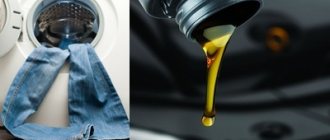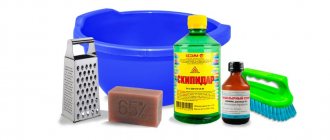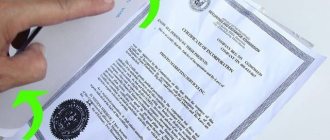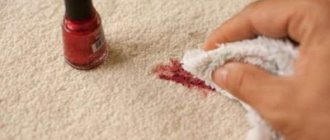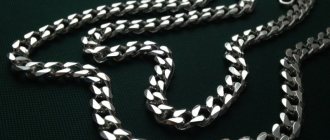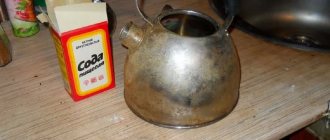Home page » Home and comfort » Washing
Author of the article
Svetlana Pavlikhina
Reading time: 4 minutes
AA
When black greasy marks are found on clothes, the question arises of how to wash fuel oil from jeans, because this is not at all easy to do. Men can get dirty at work related to transport or technology, a child on a carousel, anyone on a bus.
If you start cleaning immediately, it is possible to remove the fuel oil using special means and folk recipes.
General recommendations
Jeans have a dense structure, which makes cleaning from oil stains difficult. In this regard, when removing such contaminants, the following recommendations should be taken into account:
- New products must be tested on an inconspicuous area before first use. Aggressive substances can change the color of jeans.
- You need to wipe off stains from fuel oil, moving from the edge to the center.
- Place paper or fabric folded in several layers under the contaminated area. This will prevent the fuel oil from spreading to the clean part of the jeans.
- Before cleaning, wet the material along the contour of the stain. Thanks to this, after the procedure there will be no noticeable trace of fuel oil left on the jeans.
- Oil stains must be removed manually. Machine washing cannot clean the material.
- After removing the fuel oil, jeans should be washed separately from other clothes.
When cleaning thin jeans, it is recommended to first use mild detergents such as dishwashing liquid, gradually moving to more aggressive stain removers. To remove residual contamination, the material must be washed in a machine.
Rules for dealing with stains
It is unlikely that you will be able to remove a fuel oil stain without strong agents. Therefore, in order not to damage the item, during cleaning you should adhere to the rules described below.
- To make sure that the fabric does not change color or damage its structure, be sure to test the cleaning product on an inconspicuous area of the clothing.
- Always clean from the edge of the stain towards the center.
- Place fabric or paper folded in several layers under the stain so that the stain does not transfer to the back of clothing or other things.
- To ensure that the outline of the stain does not remain after removing it, moisten the area around it with water before cleaning.
- First wash items contaminated with fuel oil by hand and only after the stain has been completely removed, put them in the washing machine with the rest of the clothes.
How to clean jeans from fuel oil
It is recommended to clean fuel oil at home immediately after drops get on your clothes. In such cases, you should run a heated iron several times over the paper laid on top of the dirt. At the end of the procedure, the problem area should be treated with fir oil. If the liquid has managed to soak into the jeans, more aggressive methods of exposure are used.
Removing large stains
Gasoline helps to cope with complex, large and old stains.
To remove fuel oil from jeans, you will need:
- Soak a cotton pad in gasoline and treat the dirty area.
- Periodically change cotton pads as they become dirty. Fuel oil liquefies when it comes into contact with gasoline.
- If the oil stain turns out to be large, soak the jeans in gasoline for 2 hours.
- Hang the pants in the fresh air and leave for at least 12 hours.
- Wash the stain first with laundry soap, and then in a washing machine with powder.
Refined gasoline, which is sold in hardware stores, can successfully remove fuel oil stains from dense materials.
A similar result can be achieved using kerosene or diesel fuel.
Delicate cleaning
To clean thin jeans, it is recommended to use butter. The latter disrupts the structure of the resin, which is part of the petroleum products, thereby diluting the stain and simplifying the removal of contaminants. You can clean your jeans from fuel oil as follows:
- Rub a hard piece of butter onto the dirty area.
- Pour in detergent and leave for 5 minutes.
- Rub in with a soft bristle brush.
The described method helps to cope with fresh stains.
At the end of the procedure, it is recommended to additionally wash the jeans in the machine.
Removing old stains
A mixture of the following components helps remove old fuel oil from jeans:
- starch (1 tsp);
- white clay (1 tsp);
- ammonia (6 drops);
- turpentine (1 tsp).
This mixture can be used for cleaning dense materials. This product will corrode thin fabrics.
A mixture of the above components should be applied to the dirty area and left for several hours. After the slurry has hardened, the composition must be brushed off, and then the jeans must be washed by hand or in a machine.
An effective method for removing various stains
If it is not known when the fuel oil stain appeared, toluene should be used.
To clean up dirt you need:
- Soak a cotton pad in toluene and apply to the dirty area for 2-3 minutes.
- Cotton pads need to be changed as they become dirty.
- Wash the problem area with laundry soap and then in a washing machine.
Toluene is difficult to find in its pure form. But this substance is part of many cleaning products and solvents for varnish or paint.
Toluene is toxic. Therefore, when cleaning jeans using the methods described, you must wear gloves and a mask. The procedure should be carried out in a well-ventilated area.
Cleaning white jeans
You can clean white materials from petroleum products using the following algorithm:
- Wet the material with water and apply laundry soap.
- Wipe without pressing with a soft bristle brush.
- Rinse in water and repeat the steps described.
- Wash by machine or by hand.
If after 2-3 procedures the dirty area does not become lighter, the clothes should be dry cleaned.
Instead of laundry soap, you can use a water solution of soda.
Professional chemistry
There are no universal stain removers that can cope with fuel oil on jeans. Therefore, car shampoos are used to clean such contaminants. Prices for such products vary widely (from 70 rubles and above).
To clean clothes, you should buy car shampoos that do not contain wax or other additives.
To remove fuel oil, you need to dilute this product in water and soak your jeans in the solution for several hours. After this, the clothes must be washed in the washing machine.
Watch the video on how to get rid of fuel oil from clothes of any type of fabric.
Fuel oil should be removed immediately after contact with jeans. Otherwise, to clean such contaminants, you will have to use aggressive agents that can harm your clothes.
Source of the article: https://you.cleaning/stirka/kak-otstirat-mazut-s-dzhinsov
How to wash fuel oil from jeans: top 5 ways - Happy Home, How to wash fuel oil from jeans.
Why are stains difficult to remove?
Mazut is a petroleum product. It is used to operate mechanisms, so the composition of the substance is stable.
It is difficult to remove fuel oil from denim clothing, as it is a highly viscous product with increased density. These characteristics are necessary for lubrication and sliding. Upon contact with clothing, the substance is deeply absorbed into the fibers. Fuel and lubricants have a black-brown color, so stains that are not removed can ruin the appearance of the item.
Petrol
- petrol;
- a cotton pad, a piece of clean cloth or cotton wool.
- Apply a little flammable product to cotton wool or a cotton pad. And use this disc to carefully walk over the fuel oil stain. When interacting, gasoline dissolves thicker fuel oil, which is partially absorbed into the cotton wool.
- If necessary, change the disc as many times as necessary until the mark becomes barely noticeable.
- If the contamination is severe and extensive, it would be a good idea to soak the entire pair of jeans in gasoline for two hours.
- After cleaning the jeans, hang them in the fresh air to air for several hours.
- To consolidate the result, wash the stain first with laundry soap, then run it in the washing machine with several rinses.
Note! For this method, regular fuel from a gas station will be ineffective. Therefore, you need to stock up on special gasoline - purified. You can buy it at a hardware store.
Advice! Instead of gasoline, you can use other flammable substances: diesel fuel or kerosene. The process technology is the same.
Thin fabrics
It is highly undesirable to remove fuel oil stains from light natural or synthetic fabrics using the first product that comes to hand. This way you risk hopelessly ruining the item. Therefore, clean using gentle methods. To remove fresh stains, use dishwashing detergent. Apply a few drops to the problem area, rub thoroughly and leave for half an hour. Rub the stain with your hands again and soak for 10-20 minutes in warm, soapy water. Then rinse well and machine wash.
It is better to treat colored fabric with a product made from turpentine and ammonia. Mix the ingredients in a 1:1 ratio and heat slightly in a water bath. Dip a sponge into the mixture and gently press onto the dirt. Leave for a few minutes. Then wash in a strong soapy solution, rinse thoroughly and put in the washing machine.
Fir oil does an excellent job of removing fuel oil stains from natural fabrics. Place a cotton pad or a cloth folded in several layers under the stain. Dampen a sponge with oil and rub the stain with gentle movements until it disappears completely. After treatment, wash the item with laundry soap, rinse and finish cleaning in an automatic machine.
If the previous methods do not help, try pouring hot turpentine into the stain. After half an hour, sprinkle it with baking soda, rub it gently and rinse under running water. After the fuel oil has completely disappeared, wash the item in the machine.
Toluene
- toluene or a cleaning agent based on it;
- a cotton pad, a piece of clean cloth or cotton wool.
- Soak a cotton pad in a toluene-based product and apply to the stained jeans for 2-3 minutes. The fuel oil will begin to dissolve in toluene.
- Change the cotton wool to clean one and repeat the procedure several times until the fuel oil stain is completely removed.
- Wash with laundry soap.
Advice! It is unlikely that toluene can be found in its pure form; it is used only in laboratory conditions. But toluene is included in a number of cleaning products or solvents for varnishes and paints. Cleaning of fuel oil contaminants with these means must be carried out in accordance with the instructions.
Important! Don't forget about safety rules. Toluene is very toxic and also has harmful effects on the skin. Therefore, when working with it, you must wear a mask and gloves. The room in which cleaning is carried out must be well ventilated.
Traditional methods for removing stains
A common method is to soak it in a baking soda solution for an hour. To prepare it, 250 g of soda (half a standard pack) is diluted in 10 liters of water. Other methods also work effectively.
Starch
The following compositions are prepared on its basis:
| Compound | How to use |
| Starch+chalk | Mix half a teaspoon each of chalk and starch powders. Add a mixture of turpentine and ammonia (3 drops of each). Stir until smooth. Apply to stain. Let dry. clean with a brush. Wash as usual. |
| Starch + baking soda | Mix 1 tsp. ammonia and turpentine. Pour the mixture of dry ingredients into the resulting liquid (2 tablespoons of each). Apply in the same way as the first one. |
Ammonia and turpentine
They are used separately or mixed in equal volumes. The cleaning principle is the same in both cases:
- Dampen the oil stain using a cotton pad.
- Leave for 30-45 minutes.
- Wash by hand.
- Rinse in a weak solution of 9% vinegar (1 tablespoon per liter of water).
- Wash in the machine, doubling the amount of washing powder.
Acetone
When working with it you must wear gloves. Protect your respiratory system with a mask. Acetone liquid discolors fabrics. Therefore, it is not advisable to use it for jeans dyed with unstable dyes.
Toluene
It is not sold in its pure form. To split fuel oil, solvents R-4 and R-12 with a high (60%) toluene content are used. Using it for cleaning, you need to:
- Keep windows open:
- Wear gloves when cleaning;
- Protect your face with a gauze bandage.
Petrol
Used in extreme cases when there is no suitable alternative. Use, like ammonia, turpentine, acetone, toluene. Apply first to cotton wool and then wipe the oil stain.
Heated iron
Removes the bulk of fresh fuel oil. Place newspaper on the front and back of the jeans. Iron with a hot iron, changing the blotting paper several times. Remove the remains with essential oil. Complete processing by machine or hand wash.
Butter
Delicate product for removing fresh stains. Apply to the stained area for 15-20 minutes. Wash off with glycerin soap. Alternatively, you can use margarine.
Supermix for cleaning
- turpentine,
- ammonia,
- White clay,
- starch,
- brush.
- Take the indicated “ingredients” in equal parts and mix thoroughly.
- Apply the resulting slurry to the fuel oil stain and leave for a couple of hours until it dries.
- Remove the dried mixture with a brush and wash the jeans.
This paste is not aggressive towards fabrics, so the likelihood of ruining the item is minimal.
How to remove old stains
Turpentine.
- Heat it to a temperature of 50-60 °C.
- Dampen the stain.
- Sprinkle soda on top.
- After half an hour, rinse thoroughly.
- Wash.
Clay paste works effectively. To prepare it, mix:
- 2 bags (50 g) of white clay (sold at the pharmacy);
- 45 g starch;
- 50 ml of ammonia;
- 50 ml turpentine.
Treat the stain with the prepared gruel.
General recommendations and rules
And finally, a few more tips for those who decide to remove oil stains at home:
- After treatment with chemicals, the fabric may lose color. To avoid this problem, apply the selected substance to an invisible area of clothing or a piece of similar fabric, and only then experiment on the jeans themselves.
- To avoid streaks, you need to clean from the edge of the stain to the center.
- When using flammable substances, stay away from fire.
- It is better to wash the stain from the wrong side.
As practice has shown, it is difficult to wash fuel oil from jeans. But still real. And you don’t have to run to the dry cleaner for this. If you know the technology, it is quite possible to get rid of pollution at home.
Source of the article: https://www.veseldom.com/kak-otstirat-mazut-s-dzhinsov/
How to wash fuel oil from clothes, jeans and jackets - all 16 ways, How to wash fuel oil from jeans.
Outerwear
Often, fuel oil stains appear on outerwear. In this case, the housewife has to look for a way to wash fuel oil from a down jacket, jacket or sheepskin coat. For cleaning outerwear, it is best to use the same products as for thin, delicate fabrics. In some cases, you can use car shampoo or make a homemade paste. They are good for processing down jackets and down jackets. It is not recommended to clean sheepskin coats from fuel oil at home. It is better to entrust it to professionals and take it to dry cleaning.
Removing oil stains is a troublesome and difficult task. Even if you manage to wash the substance from jeans or other clothing once, try to be more careful in the future and look around carefully. It may not be possible to bring the item into proper shape the second time.
How to remove fuel oil stains from clothes - 16 methods, taking into account the fabric
Fuel oil is a dark brown or black liquid similar in consistency to machine oil. It is obtained as a result of oil refining, so it is extremely difficult to remove from clothing. Many have seen the clothes of workers whose work is related to machines - all their things are stained with similar stains. It is impossible to wash it in a machine, but in this article we will tell you how to wash fuel oil at home. Don’t rush to throw away the soiled item; stains can be removed not only from overalls, but also from everyday clothes!
- Precautionary measures
- What to do first
- Pay attention to the type of clothing
- Gentle means
- Salt
- Iron and napkins
- Shaving foam
- Baking soda
- Butter
- Starch
- Fir oil
- Aggressive approach to difficult stains
- Ammonia
- Bile soap
- Petrol
- Solvent
- WD-40
- Turpentine
- Acetone
- Household chemicals
Why is fuel oil difficult to wash off?
Fuel oil is an oily liquid of a rich brown color. It is obtained as a result of oil refining. The peculiarity of petroleum products is that they very quickly penetrate into the structure of the fibers. Therefore, regardless of whether the oil stain is “fresh” or has a history, it is very difficult to remove such stains.
You can use available home remedies or choose a cleaner that is specially made to remove greasy substances.
Important! For your actions to be successful, pre-processing is required. And the cleaning option is selected depending on the composition of the fabric and the degree of contamination.
Precautionary measures
If you notice a fuel oil stain on your clothes, you want to quickly wipe it off. This is correct, because fresh stains come off better. But many people do this with improvised means (napkins, hands, etc.), thereby smearing the dirt even more and rubbing it into their favorite T-shirt or pants. You cannot clean clothes this way, otherwise there is a risk of irreversibly damaging the item.
To prevent this from happening, the following methods will tell you how to remove fuel oil:
- If you place an item on a surface and begin to rub it, the dirt will be imprinted on the other side of the fabric. To prevent this from happening, you need to put a towel or any other thick piece of fabric on the back side (which you won’t mind later).
- It is more convenient to apply the product from the wrong side of the item, placing an unnecessary flap on the front side. This way you won’t rub dirt into the fibers, but on the contrary, you’ll get rid of it faster.
- Since fuel oil has an oily base, rubbing such a stain with a cleaning agent may spread it over a large surface. Oil contours are difficult to get rid of, so it is advisable to treat the fabric around the stain with a solvent in advance. Attention! The method is not suitable for all types of fabrics.
- When using aggressive agents (ammonium, gasoline, acetone, etc.), follow safety precautions. The label of each specific product indicates what precautions are needed. In some places it is enough to just use gloves, but in others you need a mask and goggles. In any case, the room should be ventilated, and there should be no sources of fire or things nearby that could be damaged if solutions get on them.
- Other oil stains are often sprinkled with salt to remove them. This will not work with heating oil, it will only dry out the contamination and make it harder to clean.
Application of special compounds
To remove stains left by fuel oil, only serious, targeted stain removers capable of dissolving petroleum products should be used.
Dr.Beckmann Lubricant and bitumen
Concentrated stain remover is available in small 50 ml containers. The drug is suitable for removing stubborn stains left by:
The product has been tested by dermatologists and can be used to tidy up not only adult, but also children's clothing. The stain remover is suitable for white and colored fabrics. The drug is applied to the stained area and left until the stain dissolves and its particles separate. After this, the item is cleaned and washed.
The price at points of sale is mainly up to 200 rubles. Read reviews here and here.
Duty oil
The product is intended to remove stains from lubricants and various technical fluids, including fuel oil. At its core, it is a low-foam, alkali-based detergent with a disinfecting effect. A product for removing technical oils is produced in the Russian Federation. Price for 5 liters – from 1000 rubles.
Pro-Brite Axel-6 Oil & Grease Remover
The product in spray form is intended to remove marks from industrial oils from textiles and hard surfaces. It is convenient to spray the stain remover onto the area with the stain and treat it with a brush or napkin. The product can also be used for greasy stains of plant and animal origin. The average price is up to 350 rubles.
What to do first
Of course, before using such serious means, you must first try to remove the contamination using gentle methods. It is common to use dishwashing detergent. Thanks to its composition, it easily dissolves everything that has an oil base.
- Take the dirty item and turn it inside out. Place an unnecessary fabric folded in 3-4 layers under the stain. And position it in such a way as to precisely clean the dirt without touching the rest of the matter.
- Pour detergent liberally onto the stain. The thicker it is, the more likely it is to dissolve all the oil molecules.
- Rub the detergent with your hand so that it foams and penetrates better into the fibers of the fabric. Do not overdo it, otherwise there is a chance of rubbing the stain over a larger area.
- Leave the item for a couple of hours, then wash it in a manner suitable for the fabric.
- If you didn’t manage to wash the item the first time, then try using other methods the next time you wash it (we’ll talk about them later in the article). There are also special stain removers on sale designed for such stains (for example, Vanish).
How to clean it from shoes?
To remove fuel oil stains from shoes, you need to analyze what material the pair is made of. Just as with clothing, you need to act without delay.
Fabric
Textile sneakers remove stains using the same principle as clothing . Taking into account the type of upper fabric, a suitable stain remover is selected. After the stains are removed, the sneakers are washed.
Suede
Shoes and clothes made of suede that have been damaged by fuel oil are difficult to clean due to the capriciousness of the material. Such products cannot be washed.
You can use the following approach to remove fresh stains:
It is advisable to remove any dirt that gets on your shoes as quickly as possible. Talc or chalk will help to collect the bulk of the fuel oil. The powder is poured onto the stain and rubbed in effortlessly using a brush. It is better to leave the couple in this form for a day. After a day, the chalk is shaken off, and the surface of the skin is wiped with a sponge soaked in glycerin.
Pay attention to the type of clothing
Before you begin the procedure for removing oil stains, you need to decide what cleaning agent you will use, whether it is suitable for the fabric and whether it can clean it. It is clear that it is easier to wash jeans from fuel oil than, for example, a cashmere sweater. Even some aggressive methods are used on denim, and delicate materials will not survive such treatment.
Natural fabrics wash better than synthetics, but for delicate fabrics you still need to use gentle products, for example, fir oil or soda. When it is possible to pre-check the reaction of the material to the product, do it! Inconspicuous areas of clothing are suitable for this - seam allowances, hems, etc. Along with some types of products, the kit includes a piece of fabric that is sewn to the collar or side.
Outerwear - down jacket, coat and jacket - must be checked for compatibility with the cleaning product. Try not to use aggressive products, even if it is overalls - outerwear has many layers (filling, lining, outer fabric) that can react differently to cleaning. In addition, many of the products have a difficult-to-remove odor (for example, gasoline or kerosene), which will be absorbed inside. For old clothes from the garage, this may not matter, but if we are talking about everyday clothes, then this will be a serious minus. If a sheepskin coat or fur coat with natural or artificial fur gets dirty, it is better not to even try to remove the fuel oil yourself, but to immediately take the item to dry cleaning.
Soiled rag shoes (for example, sneakers) are treated in the same way as clothing made from the same materials.
Features of removing traces from different materials
The type of fabric from which the clothes are made largely influences the rules for caring for the product , including methods of action when removing stains. When working with fuel oil, special work clothing is recommended. Dense fabrics used for overalls withstand solvents, even aggressive ones.
Difficulties in removing fuel oil from clothes arise when everyday clothes are soiled. Basic information about how to care for an item can be found by examining the label.
Jeans
Most often, jeans suffer from fuel oil and other petrochemical products. To clean these pants, you can use store-bought stain removers and home remedies .
One of the main requirements is that the selected drug should not discolor the color. Therefore, products with chlorine and bleaches are immediately prohibited.
It is advisable to immediately wash denim trousers that have just been soiled using soap or dish gel.
Can also be used:
Jackets
Products that dissolve industrial fats will help remove traces of fuel oil from bologna. It could even be regular dishwashing detergent or solvents. After treatment, the jacket will need to be washed, otherwise smudges and stains will remain on its surface.
Wool, silk, synthetics
If clothes made of wool, silk or synthetics have been damaged by fuel oil, solvents should not be used . Harsh chemicals can seriously damage fabric.
Preparations containing alcohol or ammonia will help to overcome stains on products made from such fabric. You can also use stain removers that are gentle on fabric fibers and are guaranteed not to spoil the item.
Workwear
Fuel oil can be removed from work clothes in almost any way. Even regular laundry detergents can be effective if you rub the dirt with a brush and leave it to act on the applied product.
But even on such durable clothes, targeted stain removers will give a much greater effect . Before using a new stain remover, it is best to test its effect on an inconspicuous area.
Gentle means
Gentle products are the first thing you should use when you see a stained area on your clothing. If you can’t wash it using these methods, you can resort to aggressive means, but you won’t ruin the product made from delicate fabric. Gentle products are safe for many types of fabrics, but you should first check the item in an inconspicuous area. Some of them are used only for fresh stains, while others can clean even dried stains.
Contrary to popular belief that oil stains can be removed by sprinkling them with salt, heating oil does not fall into this category. At best, you will not get any effect, and at worst, you will dry out the stain, and it will go into the category of old stains that can only be removed using aggressive methods.
Iron and napkins
An iron and 3-4 napkins or toilet paper can help remove fuel oil. The absorbent material is placed on both sides of the fuel oil and then ironed. You need to iron from the inside out, so the dirt will be more easily absorbed into the napkin and will not get deeper into the fibers. Under the influence of high temperature, the fuel oil will begin to “melt”, so change the napkins more often.
Shaving foam
Surprisingly, this method also works! Apply foam to the contaminated area, similar to dish soap. When it is absorbed into the fibers, the clothes will need to be washed (it is advisable to do this in a washing machine, but if the type of fabric does not allow it, then try with your hands, but it is better to put it on the delicate wash cycle).
Baking soda
A paste-like slurry is made from soda, which is applied to the greasy stain. And you can also mix baking powder for the dough with soda, then the effect will be faster. This mixture is left for half an hour to an hour, after which it is washed. Thus, fuel oil is removed even from white color.
Butter
The influence of butter softens the fuel oil, and it is easier to remove even from dense fabrics. But this method is also used for old stains.
Starch
Sprinkle starch onto the stain and then leave it for at least 15 minutes. Next, the item is sent to the wash.
Fir oil
A cotton pad is soaked in aromatic fir oil, after which it is generously applied over the fuel oil. After this treatment, the item will not only become clean, but will also smell pleasant.
How to remove using folk remedies?
It is no longer possible to wipe off a dried fuel oil stain with soap and water. Working with old stains takes longer, is more difficult , and the result is not guaranteed.
Ammonia
Ammonia purchased at a pharmacy is suitable for treating stains and splashes from fuel oil. A sponge soaked in ammonia is applied to the stain and left to act for 60 minutes. After this, the item is washed.
Tar soap
Tar soap can be purchased in the department of household chemicals . It is produced using birch tar. For processing you will need a brush. It is moistened in water and soaped. As the stain is treated, the brush is washed from time to time and soaped again.
Caustic soda
Caustic soda is a technical product based on alkali.
It is used in everyday life to clean various surfaces from difficult stains. This product is also suitable for fuel oil, but only if thick workwear and not delicate fabrics are treated.
Application procedure for fresh traces of fuel oil:
Application procedure for removing old dirt:
Refined gasoline
Refined gasoline can be used as a solvent . Moisten a napkin in the prepared product and moisten the area with the stain. After exposure, when the fuel oil begins to separate, use a brush to clean from the edges of the contamination to the center.
Turpentine
Turpentine, which is used as a solvent for oil paints, will also help with oil stains.
To increase efficiency, it is better to mix this substance in equal parts with ammonia and use it sparingly, only on the contaminated area.
Aggressive approach to difficult stains
If the item is not washed using gentle methods, aggressive agents come to the rescue. Overalls can easily withstand such treatment, but for everyday items this is an extreme case, since the means described below are a risk for them.
Please also note that overalls can be made from different materials. Coarse cotton or linen items will survive washing without problems, for example, you can wash a tarpaulin robe without loss. And, for example, you should be more careful with jeans.
Ammonia
You can use both ammonia and ethyl alcohol. A cotton pad is soaked in it, then applied to fuel oil, left for a couple of hours and washed.
Bile soap
Soap made from cow bile. Rare on sale, but if you don't have it, you can use tar. A soap solution is made from it, a brush is dipped into the liquid and clothes are cleaned with it.
Petrol
You need to use only purified gasoline, which is sold in hardware stores. The gasoline used to fill cars is not suitable - it will leave greasy stains that are difficult to remove.
Solvent
Solvents for oil paints work most effectively, but Toluene is a 100% solution. It dissolves oil molecules, but is not suitable for all fabrics.
A lubricant that every man has in his garage. Removes stains but may leave a discolored stain on clothing, so test on an inconspicuous area first.
Turpentine
Possesses similar to oil solvents. Mix it with ammonia in a 1:1 ratio to enhance the effect.
Acetone
It can also help to get rid of fuel oil from the fibers of the material. Soak a cotton pad in acetone and apply it to the fabric for a while. May discolor fabric!
Recommendations for certain types of products
In order not to completely ruin your clothes, you must follow the recommendations for the type of fabric:
| Name | natural fabrics, materials | synthetic |
| petrol | with great care | not recommended |
| acetone, caustic soda | prohibited for removal from wool and cotton | with preliminary testing in an inconspicuous area |
| liquids with acidic components: turpentine, ammonia | cannot be used on velor | prohibited for use on viscose |
| dishwashing detergents, essential oils, tar soap | Can | allowed |
Important! When using caustic soda or solvents, use personal protective equipment and ventilate the room.
Household chemicals
If you don’t want to experiment with household and aggressive products, you can purchase specialized chemicals in the store. A common stain remover is Vanish. It has a good reputation as a product that removes almost all types of stains. But there are also other brands; each product comes with detailed instructions for use.
Source of the article: https://textilegu.ru/vyvesti-pyatna/chem-vyvesti-mazut-s-odezhdy.html
